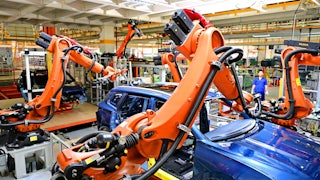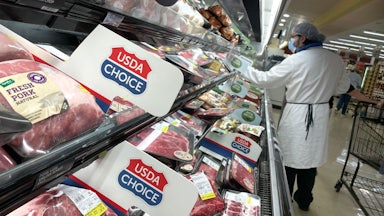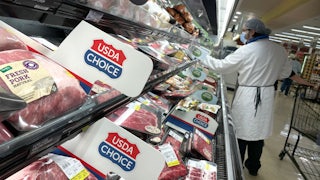On Monday night, Donald Trump announced plans to impose sweeping tariffs on some of America’s largest trading partners. Goods imported from Mexico and Canada will be subject to a 25 percent tariff, Trump said, while those from China will face a 10 percent tariff. Whether or not these particular measures are enacted, the next administration—whose ringleaders have long promised to rid the country of everything from clean energy tax credits to a nonexistent “electric vehicle mandate”—could determine the future of the U.S. auto industry.
Trump has an isolationist agenda, and American carmakers are already quite isolated. Looser regulations, higher tariffs, and scaled-back incentives to invest in electric vehicles could further separate domestic automakers from global markets where they’re struggling to compete. These policies could also encourage U.S. automakers to double down on their bestselling, mostly gas-guzzling trucks and SUVs that are primarily sold in North America.
That could harm car companies themselves, in addition to the climate. U.S. car companies, as well as European companies with a significant American presence, “have to be careful, because they also need to export vehicles to the rest of the world,” says Michael Robinet, executive director of Automotive Advisory Services at S&P Global Mobility. “If the rest of the world is accepting battery electric vehicles, then increasingly our internal combustion engine–focused offerings are going to have more difficulties in export markets.”
Automakers have said they’d like to keep some of the E.V. incentives that Trump has attacked. A trade association representing General Motors, Ford, Toyota, and several other carmakers sent a letter to Trump on November 12 urging him to preserve electric vehicle tax credits furnished by the Inflation Reduction Act and protect them from “heavily subsidized electric vehicles and technologies exported from China.” The lobby group, though—the Alliance for Automotive Innovation—wrote in the same letter that it hopes Trump will weaken “federal and state emissions regulations” that it dubs “out-of-step with current auto market realities,” claiming that they “increase costs for consumers.”
Yet these allegedly burdensome standards have been an important factor in forcing domestic carmakers to get with the times. The Environmental Protection Agency’s Automotive Trends Report, released on Monday, notes that E.V. sales in the U.S. have doubled since 2022, although they still make up just 10 percent of new cars. In 2023, fleetwide emissions in the U.S. improved 4.3 percent over 2022 levels; fuel economy rose by 1.1 miles per gallon.
“These are improvements the auto companies could have made in prior years but didn’t, and only did now because they were required to do it” by new fuel efficiency regulations, says Dan Becker, director of the Center for Biological Diversity’s Safe Climate Transport Campaign. Car companies are calling for watering down rules, he argues, because “they want to be able to cheat and get away with it.” GM was caught doing exactly that this year, and is being forced to pay a $145.8 million penalty after a multiyear federal investigation found GM vehicles from the 2012–2018 model years had emitted 10 percent more carbon dioxide on average than the company’s compliance reports claimed.
The “Big Three” U.S. automakers (Ford, GM, and Chrysler owner Stellantis, a European firm) have specialized in building big, expensive cars and largely ceded the market for smaller vehicles to foreign automakers. A series of heavy tariffs targeting Japanese-made cars throughout the 1980s and ’90s sought to protect Detroit as consumers drifted toward more fuel-efficient, foreign-made vehicles amid rising gas prices. Those measures incentivized foreign firms to build plants here—mostly nonunion, mostly in the American South, as it turned out—in order to avoid levies on models made abroad. The result has been a loosening of the Big Three’s dominance over the U.S. auto market. In 1978, the Big Three sold almost 95 percent of cars bought in the U.S. By 1989 their market share had dropped below 70 percent; in 2023, it had dipped below 40 percent.
By continuing and expanding upon the first Trump administration’s tariffs, the Biden White House hoped to once again protect domestic automakers—the Big Three, especially—from foreign competition, this time from China. Trump may well exacerbate that trend, while also removing whatever modest incentives legacy automakers had to catch up.
“I can imagine a situation where the U.S. automakers are content with a seemingly stable but slowly declining market, where they start to retreat from international markets,” says Kyle Chan, a postdoctoral researcher at Princeton University who studies industrial policy. China—the world’s largest car market—has been an important buyer of U.S. and European-made vehicles. But demand for those products has declined in recent years as consumers there increasingly opt for cheaper, domestically made cars that are eligible for a range of E.V. incentives. The country’s recent economic troubles have dented demand for pricier imported cars too. And as companies like BYD and Nio begin to compete in other important markets for U.S. firms, like Brazil, Chan adds that the Big Three and others could reach a point “where they’re really just competing on an island, separate from the rest of the global auto market.”
It’s too early to tell how much of Trump’s bluster will translate into actual policy. Back in August, a group of 18 Republican members of Congress urged House speaker Mike Johnson not to scrap IRA subsidies that are helping to court private investment in their districts. Still, the fact that red states have been among the main beneficiaries of the Inflation Reduction Act may not be enough to keep the GOP from targeting it. Fuel efficiency standards are potentially even more vulnerable. Automakers may well succeed in getting weaker rules and other sweetheart deals from Trump over the next four years—and could pay the cost in the long run.








